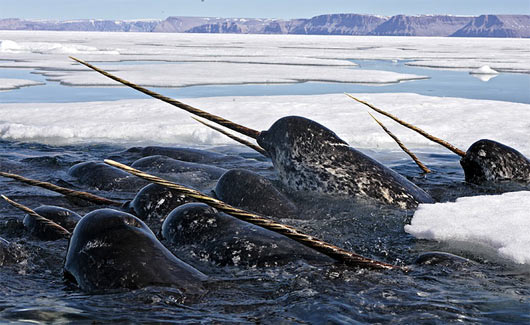Narwhal – Unicorn of the Sea

The narwhal is the unicorn sea whale. Its most distinctive features is its spiral tusk, a highly modified tooth (usually the left) that erupts from the upper jaw in males and may grow to 10 ft (3 m) long. On extremely rare occasions, two tusks may erupt in males or a single tusk may erupt in females. It has been suggested that, although the tusk is hard, it is a sensitive membrane. Like a sensor or probe it is capable of detecting changes in water temperature, pressure and particle gradients, such as salinity.

The narwhal is a dark bluish gray when young, fading to blotched gray in adults and with a lighter, relatively unmarked belly. The body is robust and without a dorsal fin (although there is a slight hump). The pectoral fins are small and rounded and the flukes (tail) are broad and rounded and become upturned with age. The young are about 5-5.6 ft (1.5-1.7 m) at birth and grow to about 12.5-16.5 ft (3.8-5 m) at maturity.
The narwhals live in a limited range in the high arctic, occupying one of the most northerly distributions of any cetacean (whales). This and their somewhat limited diet makes vulnerable to climate change. They eat a diet of fishes, squid and crustaceans. They migrate with the advancing and retreating ice, usually in deeper water than their cousins the beluga whales.
Narwhals are heavily hunted in Greenland and the eastern Canadian Arctic.
